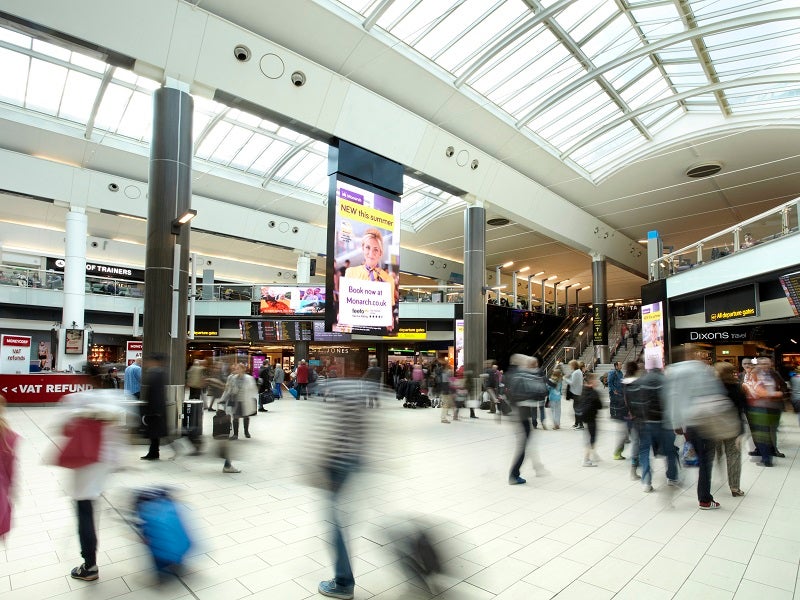
From the window of a Turkish Airlines plane on one of the two runways at Istanbul’s slick new airport, it is possible to see eight large HSBC advertisements. Half of these are on Jet bridges – an advertising concept which HSBC pioneered back in 2001 – the other half are on the side of the terminal building, directly in line with the passenger’s gaze.
Currently Istanbul airport welcomes almost 70 million passengers a year, but with capacity for 90 million passengers, it is still only half built.

Discover B2B Marketing That Performs
Combine business intelligence and editorial excellence to reach engaged professionals across 36 leading media platforms.
Terminal One, which is over 1.4 million m2 – six times the size of Heathrow Airport – opened in April 2019 and is the largest airport terminal building in the world. When the final phase is completed it will have six runways, four terminals and capacity for 150-200 million people. The advertising opportunities are set to increase dramatically.
According to airport advertising experts JCDecaux – who operate in 210 airports around the world – advertising powerfully engages passengers during long “dwell times”. These are moments such as looking out of an aircraft window waiting for the plane to load and taxi to a runway. They report that 85% of passengers would respond to an airport advertising message during this time.
A Nielson study commissioned by Clear Channel Airports (CCA) revealed that frequent flyers were particularly responsive to airport advertising, with 80% noticing the advertising and 42% actually taking action. This includes visiting the website or shop, or finding out more about the product or service.
Airports “pivotal” to HSBC’s advertising strategy
Last year HSBC launched its “Together We Thrive” advertising campaign, which spanned five languages and 17 airports, including London Gatwick and Heathrow, Vancouver International, Los Angeles LAX, Sydney International, Hong Kong International and Paris Charles De Gaulle.

US Tariffs are shifting - will you react or anticipate?
Don’t let policy changes catch you off guard. Stay proactive with real-time data and expert analysis.
By GlobalDataDeveloped by Saatchi & Saatchi, the airport campaign covered 1,500 air bridges and 94km of airport walkways. The hexagon design – of which there were 79 versions overall – was created to represent key focus areas for the bank’s business, including education, trade and sustainability.
“Our airport campaigns have caught the attention of millions of travellers across the world over the years and remind our customers that we are there to share their journeys with them,” says Leanne Cutts, HSBC’s Group Head of Marketing. “With global air traffic forecast to double to 14 billion passengers per year by 2029, airports will continue to be a pivotal part of our marketing strategy.”
In order to understand just how much benefit comes through advertising to air passengers, HSBC created the Flyland concept, which the company uses to describe the potential value of the 11.9 million people who fly on a daily basis.
Research from HSBC states that Flyland’s economy is worth $400.5bn (GDP calculated as the sum of expenditures) with “$1.26bn being added every day”. This, they report, is similar, to Norway’s GDP, making Flyland the 25th largest economy in the world.
“Nine hundred million people around the world walk onto a plane through an HSBC-branded jet bridge every year, and make their journey into Flyland,” says HSBC UK head of personal banking Becky Moffat. “This country in the sky is a thriving economy where many travellers do some of their best business – whether it’s having the headspace to come up with the next big idea; free time to sit back and read that inspiring book; or meeting their future business partner.”
Airport adverts considered prestigious and trustworthy
With the majority of air travellers arriving more than an hour before boarding and 88% walking the concourse, the airport offers plenty of advertising opportunities to a captive audience. Some of the most impactful locations for targeting travellers are eye-level screens and video walls in busy concourse areas, around flight information display units and baggage reclaim.
The CCA study profiles three main categories of traveller: air traveller (one or more trips per year), frequent flyer (three or more trips a year) and business frequent flyer (three or more business trips a year).
There is a wealth of opportunity for targeting business travellers at airports with 79% travelling as they believe face-to-face meetings are still important, despite the extensive range of communication tools technology offers.
JCDecaux says a recent study revealed that 92% of business travellers would respond to an airport advertisement because companies advertising in this area are regarded as being trustworthy and important. It also showed that 93% use apps on the move with cloud-based file sharing one of the most popular. While the primary reason is for work, it’s also ideal for mobile banking and TV on demand.
A VR tour shows advertising potential at Sydney Airport
In a bid to show brands and businesses exactly what passengers see as they pass through Sydney Airport, JCDecaux Australia recently created a virtual reality (VR) site tour by partnering with Catalyst VR, which enables advertisers to see where the specific touch points are and understand their economic potential.
Sydney Airport welcomes around 44 million passengers a year and is the busiest in Australia. The average dwell time is 135 minutes at Terminal One.
All touchpoints of a passenger journey are included, such as check-in, departure gates, the arrivals hall, as well as exterior locations such as car parks, which will help businesses to understand exactly what a traveller sees when they’re moving through the airport.
“Advertisers will be able to view the virtual tour of Sydney Airport through existing devices, including their mobile or tablet, via a web browser or by using virtual reality headsets,” explains Catalyst VR managing director Jamie Gilroy. “It’s a unique, immersive and realistic experience of what a passenger sees.”





